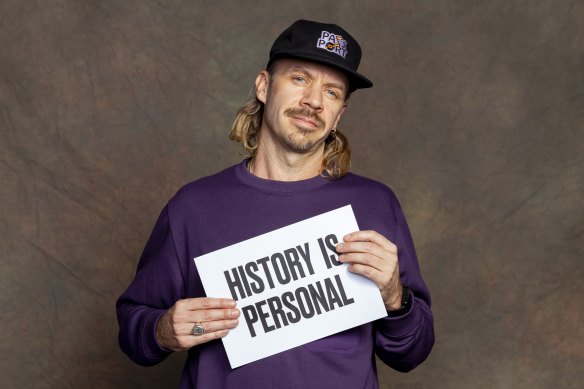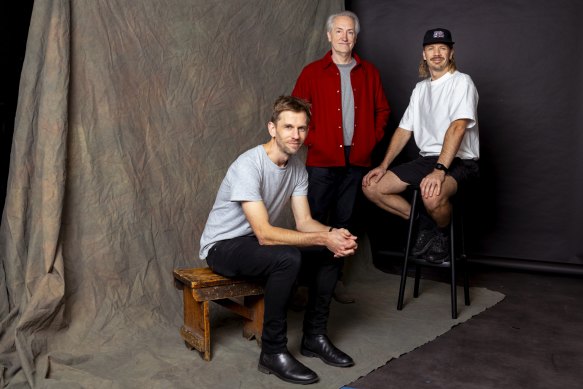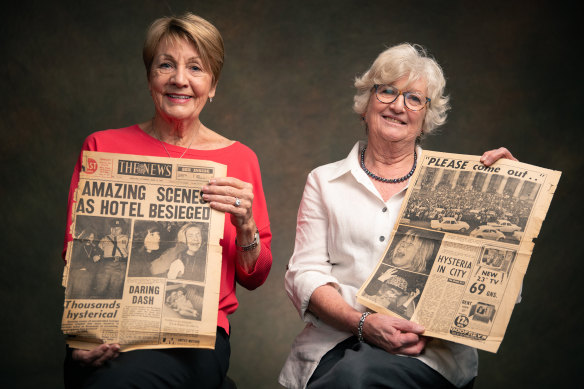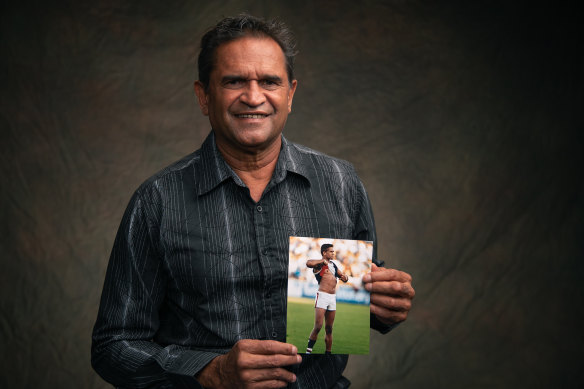Man of the moments: You Can’t Ask That team return, and this time it’s personal
I Was Actually There revisits big moments in Australian history with eyewitnesses, and makes for riveting viewing.
By Karl Quinn

Kirk Docker, who co-created You Can’t Ask That, is back with a new format, I Was Actually There.Credit: Dominic Lorrimer
The trick with formats is creating rules,” says documentary director Kirk Docker. “And now we know how this thing works, I think we can plug in different events and different ideas, and it’ll be far easier if we get a second crack at it.”
The “it” in question is I Was Actually There, a six-part factual series for the ABC in which people recount their first-hand experiences of a range of Big Moments in Australian history: the Port Arthur massacre; the Boxing Day tsunami; the Beaconsfield mine collapse; the Beatles’ tour of Australia; AFL footballer Nicky Winmar’s bold stand against racism; and the Woomera detention centre breakout.
Docker created the format with cinematographer Aaron Smith and producer Jon Casimir, the same trio who came up with You Can’t Ask That. And if that show is any indication, there’s every chance they will indeed get a second crack with their new one.
You Can’t Ask That is, Docker claims, “the most-sold format in Australian history. It’s about number 18 globally. We’re right up there with Big Brother. There’s something like 45 seasons of the show around the world, it’s in 16 territories, 10 languages. It’s amazing.”

I Was Actually There co-creators (from left) Aaron Smith, Jon Casimir and Kirk Docker, in front of their bespoke backdrop.Credit: Dominic Lorrimer
You’d think the royalties flowing from all those format sales – in which production companies buy the rights to remake the show for specific territories – might make Docker, Smith and Casimir very wealthy. But you’d be wrong. They don’t own the IP (intellectual property) rights to the show they created – the ABC does.
“I’ve very much moved past that,” Docker says, with an equanimity that suggests he actually means it. “I was probably annoyed about it five years ago, but I’m completely fine now. Because it’s really just money, and I learnt a shitload on that show, I was given a lot of freedom, there was no one breathing down my neck, it was just, like, go for it.”
Docker and Smith were alumni of Hungry Beast, the ABC comedy-current affairs hybrid program that aired from 2009 to 2011. Casimir was one of the show’s producers (along with Andrew Denton and Anita Jacoby). Hungry Beast was seen, and indeed served as, a testing ground for up-and-coming talent; the likes of Marc Fennell, Dan Ilic and Kirsten Drysdale got their starts there.
When Docker, Smith and Casimir took the idea of You Can’t Ask That to the ABC, it was seen as a low-cost, low-return exercise. “When we first got commissioned, it was 10 x 10 minuters for iview,” Docker recalls. “We were 33 years old, we were trying to get our own thing up, and this was a way in. It was like, ‘Here’s some iview money, you can make it with your team, how you want it, but we’re gonna own the rights’. It wasn’t even going to get broadcast on TV.

Ann Domingo and Hennie Noll feature in the episode about the Beatles’ visit to Adelaide. Credit: ABC
“It felt like a good deal for us at the time,” he adds. “But of course, we’re not going to sign that deal again.”
The idea for I Was Actually There grew out of the earlier series. “We did an episode on disaster survivors, some from Port Arthur, someone from the Bali bombing, bushfires, floods, Cyclone Tracy,” Docker says. “And I remember having a conversation with a woman from Port Arthur and I thought, ‘I haven’t really heard this take before’. She’d become quite obsessed with it. She collected everything, she’d watched everything. And I felt if I sat next to someone at a dinner party and they said they were at Port Arthur, you’d want to know about their experience; it just felt like a no-brainer.”
The key thing was to tell stories we all thought we knew, but from a range of perspectives that we mostly haven’t heard before. The episode about the Beatles visiting Adelaide in 1964 – an event that saw half the population of the city turn out for a glimpse, and gave a teenage John Brewster the impetus to form a band of his own (he went on to co-found the Angels) – offers a bit of light relief.
The Nicky Winmar episode of course revolves around the famous photograph taken by Wayne Ludbey for The Sunday Age, but also makes much of the rivalry between him and the Sunday Herald-Sun’s John Feder, and the ways their respective papers treated the story. It breathes fresh life into a story that Melburnians in particular might have imagined they already knew inside and out.
One of the rules of the format is that none of the people interviewed is identified on screen (they are, though, named in the end credits).
“I don’t think it matters who they are,” Docker says. “When we originally wrote the pitch document, it was like, ‘If you’re the prime minister or you’re a cleaner, if you were there and you saw it, we’re interested in your take’.
“Their voices are all equal,” he adds. “It’s about what they saw and how it impacted them, then and over time. There were a lot of arguments over that, but I think it works.”
Equally important to who is telling the story is how they tell it. Crucially, filming is a mobile operation, with Smith working the two cameras, Docker interviewing, and their entire set-up able to come to a location that suits the interview subject.
“It’s about getting them out of telling it like they’ve told it 1000 times before, and hearing the unusual details and getting off script,” Docker says. “The more intimate it feels, the more it just becomes an interaction between me and them.”
And one other element in this format: the screen against which the subjects are shot.
Crafted in Brooklyn by Sarah Oliphant, who has made backdrops for Annie Leibovitz and Steven Meisel among others, the mottled grey-green painted canvas was one of the first items ticked off during the eight-week pre-production period on the show. But when it turned up just days before shooting began, Docker says, “My first thought was, ‘Oh no, this looks like shit’.”
Once lit, though, it took on a life of its own. And the more it is used, the more distinctive it becomes. Rather than neatly folding it for transport, Oliphant advised the filmmakers to simply scrunch it up. “Correct me if I’m wrong, but history is messy, it’s ugly, it’s crinkled’,” Docker recalls her saying. “And we were like, ‘You are speaking our language here’.”

Nicky Winmar in the ABC TV factual series I Was Actually There.Credit: ABC
The way the timer ticks over as the narrative unfolds – that is another element that gets Docker excited. “Every single one of those details is really important if you want to replicate it and have it be something that you can plug into a different event and do it again, even if the audience never picks up on them,” he says.
If this particular format catches fire, there are already some stories in line for a second season. “We had Corey Worthington’s party on the board,” Docker reveals. “We had the Bali nine executions, we had the Cronulla riots.”
And if other territories get excited by the prospect of a new format from the guys who created that hit show, well, everyone’s a winner this time.
“But that’s a nice byproduct. It’s not why we are making it,” Docker says. “We’re creating content that we care about, that hopefully makes a difference, that makes people think about the world in different ways, that challenges them and makes them reflect on their own life.
“We’re making it because we think it’s a good idea, first and foremost.”
Contact the author at kquinn@theage.com.au, follow him on Facebook at karlquinnjournalist and Twitter at @karlkwin, and read more of his work here.
Find out the next TV, streaming series and movies to add to your must-sees. Get The Watchlist delivered every Thursday.